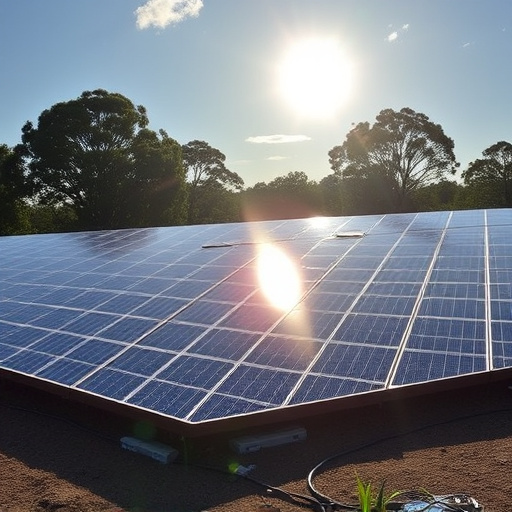Solar power harnesses sunlight through photovoltaic (PV) cells, generating direct current (DC) electricity. Solar inverters convert this DC energy into alternating current (AC), making it usable in homes and businesses, and integrating solar power into the grid. Essential for efficient solar system operation, advanced inverters with features like MPPT minimize losses and maximize efficiency. Future innovations promise improved inverter performance, reduced costs, and enhanced safety, driving wider adoption of solar power for residential and commercial applications.
Solar power has revolutionized renewable energy, offering a clean and sustainable alternative. At the heart of this transformation are solar inverters—essential components that convert the direct current (DC) generated by solar panels into alternating current (AC), usable by homes and businesses. This article explores the fundamental role of solar inverters in harnessing solar power, enhancing efficiency, ensuring reliability, and delves into future trends shaping this innovative technology.
- Understanding Solar Power: The Foundation of Renewable Energy
- The Role of Solar Inverters in Converting DC to AC
- How Solar Inverters Enhance Efficiency and Reliability
- Future Trends and Innovations in Solar Inverter Technology
Understanding Solar Power: The Foundation of Renewable Energy

Solar power, at its core, is a renewable and clean energy source that has revolutionized the way we think about electricity generation. It harnesses the sun’s abundant energy using photovoltaic (PV) cells, which convert sunlight directly into direct current (DC) electricity. This fundamental understanding of solar power is crucial to comprehending the role of solar inverters in our modern energy landscape.
The process begins with capturing sunlight, typically through panels installed on rooftops or open spaces. These panels are composed of PV cells that generate a flow of electrons when exposed to sunlight. The challenge lies in transforming this DC electricity into alternating current (AC), which is the standard form used in homes and businesses. This is where solar inverters come into play, acting as the bridge between solar energy generation and grid-connected power systems.
The Role of Solar Inverters in Converting DC to AC

Solar inverters play a pivotal role in harnessing the power of solar energy and making it useful for our daily needs. When sunlight hits solar panels, it generates direct current (DC) electricity. However, most homes and businesses run on alternating current (AC). This is where solar inverters come into play; they act as the bridge between these two types of current, converting DC to AC, thereby enabling us to utilize the clean, renewable energy from the sun effectively.
In simple terms, solar inverters transform the electrical current produced by solar panels into a form that’s compatible with our power grids and everyday appliances. This process is crucial for integrating solar power into our existing infrastructure, making it a vital component in the growth of sustainable energy solutions. By converting DC to AC, inverters ensure that excess solar energy can be fed back into the grid or used immediately, contributing to a more efficient and environmentally friendly energy system.
How Solar Inverters Enhance Efficiency and Reliability

Solar inverters play a pivotal role in enhancing the efficiency and reliability of solar power systems. These advanced devices convert direct current (DC) electricity generated by solar panels into alternating current (AC), which is the standard form used in homes, businesses, and the grid. By doing so, they bridge the gap between renewable energy production and everyday electrical needs, making solar power more accessible and efficient.
One of the key ways solar inverters enhance efficiency is by optimizing power conversion. They ensure that every watt of DC electricity produced by solar panels is effectively converted to AC, minimizing energy loss during transmission. Additionally, modern inverters are equipped with intelligent features such as maximum power point tracking (MPPT), which adjusts to varying sunlight conditions, maximizing energy capture from the panels. This not only boosts overall system efficiency but also improves reliability, ensuring consistent and dependable performance even under changing weather or seasonal conditions.
Future Trends and Innovations in Solar Inverter Technology

The future of solar power looks even brighter with continuous innovations in inverter technology. Researchers and manufacturers are focusing on making inverters more efficient, compact, and cost-effective. One notable trend is the integration of advanced digital controls, which enhance performance and allow for precise monitoring and optimization of energy production. These smart inverters can adapt to changing conditions, ensuring optimal power generation even under varying weather and sunlight exposure.
Another exciting development is the emergence of microinverters and string inverters, offering enhanced safety features and improved system reliability. Microinverters provide individual protection for each solar panel, increasing the overall safety of the system. Moreover, advancements in communication protocols enable real-time data monitoring and remote management, allowing homeowners and utilities to track energy production and maintain systems efficiently. These innovations are paving the way for more accessible and efficient Solar Power solutions, making renewable energy even more attractive for residential and commercial applications.
Solar inverters play a pivotal role in harnessing the potential of solar power, converting direct current (DC) from solar panels into alternating current (AC) that can be used to power homes and businesses. As we look towards a future dominated by renewable energy, continuous advancements in solar inverter technology are key. Innovations such as higher efficiency rates, improved heat management, and smart grid integration will not only enhance the overall performance of solar systems but also make clean energy more accessible and affordable for all. Embracing these trends is a step towards a sustainable and vibrant future powered by solar.
